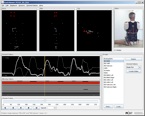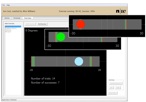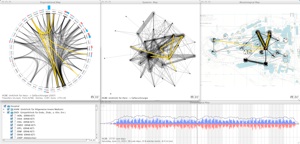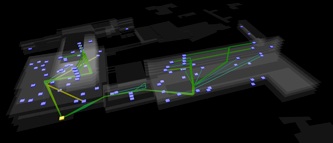FHNW
Below is a list of selected projects that I am or have been working on at the University of Applied Sciences Northwestern Switzerland (FHNW).
Backtrainer – An augmented feedback system for the therapy of chronic low back pain

An Investigation of Computer-Generated Visual Feedback for the Support of Low Back Pain Therapy
An effective way to treat low back pain is through active and supervised movement exercises. The effectiveness of such exercises however is limited by inadequate awareness of patients of their own posture, requiring the continuous supervision by a physical therapist. To increase patient independence and support physical therapy of low back pain, we built a sensor system that provides real-time information about the geometry of the low back. In this study, we investigate how this information can be turned into visual feedback that is intuitive and easy to understand. We first analyzed the whole gamut of typical movement exercises, and classified them according to the therapy goal into the two basic types of stabilizing and mobilizing exercises. A visual metaphor for each of these types was then developed, and implemented as visual feedback. To free patients from having to focus their attention on a computer screen during exercises, we used techniques from ambient visualization. The visual feedback was evaluated during five weeks in a rehabilitation clinic with 26 patients and 15 physiotherapists. Subjective satisfaction of participants was good and study results showed that the abstract visual feedback that we designed was helpful. Ambient feedback modalities proved to be a very useful addition to the computer screen in a real-life therapy setting.
D. Brodbeck, M. Degen, J. Kool, P. Oesch. An Investigation of Computer-Generated Visual Feedback for the Support of Low Back Pain Therapy. World Congress on Medical Physics and Biomedical Engineering September 7-12, 2009 Munich, Germany. IFMBE Proceedings 25/V, pp. 214-217, 2009.
eDim – eDisease Management

Enabling Large-Scale Telemedical Disease Management through Interactive Visualization
Automated collection and storage of medical data leads to large amounts of heterogeneous and time-dependent information. Out of this follows the problem of how to access and interpret this data, in order to support therapeutic decision making. Telemedical disease management holds great potential for the efficient and effective treatment of chronic diseases. The realization of this potential however depends on finding a solution to the information overload problem. This paper describes a highly interactive visualization system that gives caregivers an overview of trends and critical patterns, and provides easy access to details without loosing the big picture. We report on the results from two case studies that confirm the validity of this approach and suggest that it is well suited to enable large-scale telemedical disease management programs.
D. Brodbeck, R. Gasser, M. Degen, S. Reichlin, J. Luthiger. Enabling Large-Scale Telemedical Disease Management through Interactive Visualization. Proceedings of MIE 2005, Geneva, August 29-31, 2005. European Notes in Medical Informatics, Vol I No 1, 2005, pp. 1172-1177.
MobileMed – Mobile consultation and learning system

A transdisciplinary consortium of universities and companies is iteratively conceptualising, developing and systematically evaluating a mobile, smartphone-based system that is aimed at supporting doctors in their daily work, collaboration and learning practices.
Beyond the provision of just-in-time information from clinical information systems the framework is mainly intended to facilitate the doctors' consultation and problem-solving processes with remote specialists.
Smartphones allow the prompt sharing and discussion of diagnostic findings such as - self-generated or system based - images, videos or other clinical information to decide on the further treatment. These materials can later be re-used across formal and informal contexts such as (follow-up) meetings or training sessions. The socio-cognitive system strives to enhance communication, collaboration and learning practices of doctors and eventually improving patient care.
D. Brodbeck, M. Degen, M. Reiss. A mobile collaboration and decision support system for the medical emergency department. Proceedings of HEALTHINF 2012, 5th International Conference on Health Informatics, Vilamoura, Portugal, 2012.
DRGee – Visual planning of strategic hospital portfolios

The switch to a DRG-based health care payment system in Switzerland causes a big need for hospitals to reevaluate the profitability of their service portfolio under this new system. Consultants have developed a model to analyze portfolios and create future scenarios. In order to steer the strategy finding and communicate the results of this modeling, we developed an interactive visualization tool that allows dynamic interactions with this complex information in live strategy meetings.

xPlan – Visualizing patient flow to support strategic infrastructure planning in hospitals

Hospitals collect large amounts of data during their daily operation. Next to its immediate primary purpose, this data also contains implicit information that can be used to improve clinical and administrative processes. We present a case study of how strategic infrastructure planning can be supported by the analysis of enriched patient flow through a hospital. Data from various hospital information systems was collected, enriched with topographical and organizational data, and integrated into a coherent data store. Common analysis tools and methods do not support exploration and sense-making well for such large and complex problems. We therefore developed a highly interactive visual analytics application that offers various views onto the data. The analysts were able to validate their experiences, confirm hypotheses and generate new insights. As a result, several sub-systems of clinics were identified that will play a central role on the future hospital campus. In this case study we show that a different view on electronic health records can provide not only clinical insights but also help improve operational efficiency.
D. Brodbeck, M. Degen, A. Walter. Supporting Strategic Planning with Interactive Visualization - A Case Study of Patient Flow through a Large Hospital. Proceedings of HEALTHINF 2013, 6th International Conference on Health Informatics, Barcelona, Spain, 2013.
© 2014 Dominique Brodbeck







